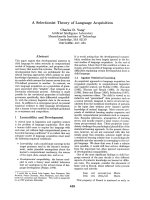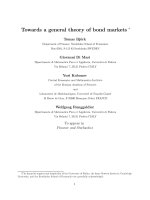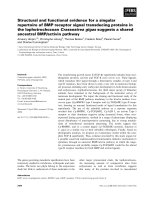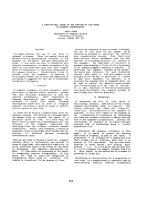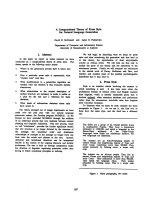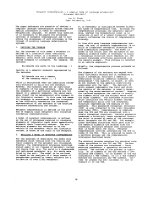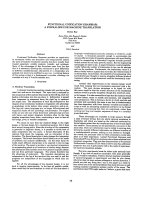- Trang chủ >>
- Khoa Học Tự Nhiên >>
- Vật lý
functional discourse grammar a typologically-based theory of language structure sep 2008
Bạn đang xem bản rút gọn của tài liệu. Xem và tải ngay bản đầy đủ của tài liệu tại đây (2.8 MB, 528 trang )
Functional Discourse Grammar
This page intentionally left blank
Functional
Discourse Grammar
A typologically-based theory of
language structure
KEES HENGEVELD AND
J. LACHLAN MACKENZIE
1
3
Great Clarendon Street, Oxford ox26dp
Oxford University Press is a department of the University of Oxford.
It furthers the University’s objective of excellence in research, scholarship,
and education by publishing worldwide in
Oxford New York
Auckland Cape Town Dar es Salaam Hong Kong Karachi
Kuala Lumpur Madrid Melbourne Mexico City Nairobi
New Delhi Shanghai Taipei Toronto
With offices in
Argentina Austria Brazil Chile Czech Republic France Greece
Guatemala Hungary Italy Japan Poland Portugal Singapore
South Korea Switzerland Thailand Turkey Ukraine Vietnam
Oxford is a registered trade mark of Oxford University Press
in the UK and in certain other countries
Published in the United States
by Oxford University Press Inc., New York
© Kees Hengeveld and J. Lachlan Mackenzie 2008
The moral rights of the authors have been asserted
Database right Oxford University Press (maker)
First published 2008
All rights reserved. No part of this publication may be reproduced,
stored in a retrieval system, or transmitted, in any form or by any means,
without the prior permission in writing of Oxford University Press,
or as expressly permitted by law, or under terms agreed with the appropriate
reprographics rights organization. Enquiries concerning reproduction
outside the scope of the above should be sent to the Rights Department,
Oxford University Press, at the address above
You must not circulate this book in any other binding or cover
and you must impose the same condition on any acquirer
British Library Cataloguing in Publication Data
Data available
Library of Congress Cataloging in Publication Data
Data available
Typeset by SPI Publisher Services, Pondicherry, India
Printed in Great Britain
on acid-free paper by
CPI Antony Rowe, Chippenham, Wiltshire
_________________
ISBN 978–0–19–927810–7 (Hbk.)
ISBN 978–0–19–927811–4 (Pbk.)
13579108642
Contents
Preface xi
List of tables and figures xiv
Abbreviations xvi
1 Introduction 1
1.1 Functional Discourse Grammar 1
1.2 Basic properties 1
1.2.1 Introduction 1
1.2.2 Top-down organization 1
1.2.3 Discourse grammar 3
1.2.4 Levels of representation 4
1.2.5 Conceptual Component, Contextual Component,
and Output Component
6
1.3 The architecture of FDG 12
1.3.1 Overall organization 12
1.3.2 Levels and Layers 14
1.3.3 Primitives 19
1.3.4 Levels and primitives 22
1.3.5 Implementation 23
1.4 FDG in its broader context 25
1.4.1 Introduction 25
1.4.2 Functionalism 26
1.4.3 Typology 31
1.4.4 Language modelling 37
1.4.5 On using FDG 41
1.5 Notational conventions 43
1.6 Structure of the book 45
2 The Interpersonal Level 46
2.1 Introduction 46
2.2 The organization of the Interpersonal Level 48
2.3 The Move 50
2.3.1 Introduction 50
2.3.2 Heads 52
vi contents
2.3.3 Modifiers 58
2.3.4 Operators 59
2.3.5 Frames 60
2.4 The Discourse Act 60
2.4.1 Introduction 60
2.4.2 Heads 63
2.4.3 Modifiers 64
2.4.4 Operators 65
2.4.5 Frames 68
2.5 Illocution 68
2.5.1 Introduction 68
2.5.2 Heads 69
2.5.3 Modifiers 81
2.5.4 Operators 83
2.5.5 Frames 83
2.6 The Participants 84
2.6.1 Introduction 84
2.6.2 Heads 84
2.6.3 Modifiers 85
2.6.4 Operators 85
2.6.5 Frames 87
2.7 The Communicated Content 87
2.7.1 Introduction 87
2.7.2 Heads 88
2.7.3 Modifiers 102
2.7.4 Operators 104
2.7.5 Frames 106
2.8 Subacts 107
2.8.1 Introduction 107
2.8.2 Ascription 108
2.8.3 Reference 113
2.9 Building up the Interpersonal Level 124
3 The Representational Level 128
3.1 Introduction: semantics in FDG 128
3.2 The organization of the Representational Level 130
3.2.1 Semantic categories 130
3.2.2 Subclasses of semantic categories 135
3.2.3 The structure of representational layers 138
3.3 Propositional contents 144
3.3.1 Introduction 144
contents vii
3.3.2 Heads 145
3.3.3 Modifiers 151
3.3.4 Operators 153
3.3.5 Frames 156
3.4 Episodes 157
3.4.1 Introduction 157
3.4.2 Heads 160
3.4.3 Modifiers 162
3.4.4 Operators 163
3.4.5 Frames 165
3.5 States-of-Affairs 166
3.5.1 Introduction 166
3.5.2 Heads 166
3.5.3 Modifiers 171
3.5.4 Operators 172
3.5.5 Frames 180
3.6 Configurational Properties 181
3.6.1 Introduction 181
3.6.2 Heads 182
3.6.3 Modifiers 208
3.6.4 Operators 210
3.6.5 Frames 214
3.7 Lexical Properties 215
3.7.1 Introduction 215
3.7.2 Heads 215
3.7.3 Modifiers 230
3.7.4 Operators 233
3.7.5 Frames 236
3.8 Individuals 236
3.8.1 Introduction 236
3.8.2 Heads 237
3.8.3 Modifiers 241
3.8.4 Operators 245
3.8.5 Frames 247
3.9 Location 248
3.9.1 Introduction 248
3.9.2 Heads 249
3.9.3 Modifiers 254
3.9.4 Operators 256
3.9.5 Frames 257
viii contents
3.10 Time 257
3.10.1 Introduction 257
3.10.2 Heads 258
3.10.3 Modifiers 260
3.10.4 Operators 262
3.10.5 Frames 262
3.11 Manner 263
3.11.1 Introduction 263
3.11.2 Heads 265
3.11.3 Modifiers 267
3.11.4 Operators 267
3.11.5 Frames 268
3.12 Quantity 268
3.12.1 Introduction 268
3.12.2 Heads 269
3.12.3 Modifiers 271
3.12.4 Operators 271
3.12.5 Frames 272
3.13 Reason 272
3.13.1 Introduction 272
3.13.2 Heads 272
3.13.3 Modifiers 274
3.13.4 Operators 274
3.13.5 Frames 274
3.14 Reflexive language 275
3.15 Building up the Representational Level 277
4 The Morphosyntactic Level 282
4.1 Introduction 282
4.1.1 Purpose and scope of the chapter 282
4.1.2 Relation to Interpersonal Level and
the Representational Level
283
4.1.3 Relation to Phonological Level 287
4.2 The organization of the Morphosyntactic Level 291
4.2.1 Introduction 291
4.2.2 Hierarchical structure 291
4.2.3 Grammatical morphemes and secondary operators 301
4.3 Linguistic Expressions 308
4.4 Clauses 309
4.4.1 Introduction 309
4.4.2 Ordering of hierarchically related units 311
contents ix
4.4.3 Alignment 316
4.4.4 Ordering of non-hierarchically related units 333
4.4.5 Templates 341
4.4.6 Dummies and support 347
4.4.7 Agreement 350
4.4.8 Subordination 352
4.4.9 Coreference 372
4.5 Phrases 376
4.5.1 Introduction 376
4.5.2 Ordering of hierarchically related units 377
4.5.3 Alignment 383
4.5.4 Ordering of non-hierarchically related units 387
4.5.5 Templates 389
4.5.6 Dummies and support 391
4.5.7 Agreement 394
4.5.8 Subordination 396
4.6 Word s 400
4.6.1 Introduction 400
4.6.2 Ordering of hierarchically related units 405
4.6.3 Alignment 406
4.6.4 Ordering of non-hierarchically related units 409
4.6.5 Templates 411
4.6.6 Dummies and support 412
4.6.7 Agreement 414
4.6.8 Subordination 414
4.7 Building up the Morphosyntactic Level 416
5 The Phonological Level 421
5.1 Introduction 421
5.2 The organization of the Phonological Level 427
5.3 Utterances 430
5.4 Intonational Phrases 432
5.5 Phonological Phrases 436
5.6 Phonological Words 443
5.7 Phonemes, Syllables, and Feet 449
5.8 Building up the Phonological Level 455
References 463
Language Index 489
Name Index 492
Subject Index 496
This page intentionally left blank
Preface
At the Ninth International Conference on Functional Grammar (ICFG9), held
in Madrid in September 2000, Kees Hengeveld proposed the idea of a Func-
tional Discourse Grammar. At the time it was conceived of as a revised version
of Functional Grammar (FG; Dik 1997a, 1997b), a theory of the organization
of natural languages developed by the late Simon C. Dik and his colleagues
from 1978 onwards, the year in which the first book bearing the title Functional
Grammar appeared (Dik 1978). The addition of the word Discourse in the
denomination of the model was meant to reflect the awareness that the impact
of discourse features on linguistic form should be given greater prominence in
the theory. A number of the features of FDG as presented in this book were
already present in Hengeveld’s (2000) presentation, notably: the distinction
between an interpersonal, a representational, and a morphosyntactic level of
analysis, all of them with hierarchical layering; the actional status of ascription
and reference; the top-down operation of the model; the interaction of the
grammatical component with the conceptual and contextual components;
and the analysis of reflexive language use.
The ideas were taken up in lively discussion in the years following that
conference, not least at ICFG10 in Amsterdam (The Netherlands), ICFG11 in
Gijón (Spain), and ICFG12 in São João do Rio Preto (Brazil). This led to such
collections as Mackenzie and Gómez-González (2004, 2005), de Groot and
Hengeveld (2005), and García Velasco and Rijkhoff (2008), in which a range
of scholars from various countries contributed to the development of a new
architecture of the theory, with a strong desire to retain the best of FG while
increasing the scope and ambition of the model.
Just like FG, FDG seeks to reconcile the patent fact that languages are
structured complexes with the equally patent fact that they are adapted to
function as instruments of communication between human beings. FDG has
also inherited from its precursor the desire to achieve maximum typological
neutrality: the theory is designed to be equally applicable to languages of all
types, and indeed this book presents and analyses data from a very wide range
of languages, resorting to exemplifying from more familiar languages only
where the comprehensibility of the presentation makes this advisable.
However,FDGdivergesfromFGinsomanywaysthatbynowitshouldbe
considered a theory in its own right, and it has been recognized as such, as evi-
denced by encyclopaedia entries such as Hengeveld and Mackenzie (2006,fc.)
and special issues of journals on FDG (van Staden and Keizer fc.; Hengeveld
xii preface
and Wanders fc.; Hattnher and Hengeveld 2007). FDG represents a significant
advance on FG in separating out the Interpersonal Level and the Represen-
tational Level and investigating the full complexity of the former as well as
the complex interaction between the two in determining linguistic form. It
also differs from its predecessor in regarding the Morphosyntactic Level and
the Phonological Level as more than mere expressions of the other Levels,
but as having their own principles of organization; these are fully elaborated
forthefirsttimeinthisbook.Andfinally,itdiffers crucially from FG in
being a top-down rather than a bottom-up model. All in all, then, FDG has
outgrown its intellectual origins and now offers an autonomous and balanced
account of the systematic impact of pragmatic, semantic, morphosyntactic,
and phonological phenomena on linguistic form.
The present book began life during a joint sabbatical of both authors
in Amsterdam in 2004. It then continued to grow in the form of e-mail
correspondence, with drafts being sent back and forth between Amsterdam
and Lisbon when other commitments permitted. In the last phase Mackenzie
was awarded a Visitor’s Scholarship from the Netherlands Organization for
Scientific Research (NWO) for the first months of 2007 under project number
B30-664, when he was able to work together with Hengeveld on a daily basis in
Amsterdam again. Mackenzie also wishes to acknowledge support received in
the early days from the Spanish Ministry of Education, the European Regional
Development Fund and the Xunta de Galicia under project number BFF2002-
02441 (PGIDIT03PXIC20403PN), and Hengeveld is grateful for support pro-
vided by the Amsterdam Center for Language and Communication and the
Department of Theoretical Linguistics of the University of Amsterdam.
We also wish to recognize the contribution of innumerable colleagues and
students who over the past years have contributed their ideas, encouragement,
and criticism to our enterprise of developing FDG. We were fortunate enough
to be given the opportunity to present FDG at conferences, in postgradu-
atecourses,andinguestlecturesatmanydifferent places, and though we
cannot name all those who contributed with their questions, remarks, and
criticisms (for there have been so many), we would like to thank in gen-
eral terms our audiences at ICFG10 (Amsterdam, The Netherlands, 2002),
International Conference on Role and Reference Grammar (Logroño, Spain,
2002), LOT Winter School (Amsterdam, The Netherlands, 2003), Journées de
Linguistique Fonctionelle (Agadir, Morocco, 2003), ACLC/ILLC-Colloquium
(Amsterdam, The Netherlands, 2003), Københavns Universitet (Copenhagen,
Denmark, 2003), Århus Universitet (Århus, Denmark, 2003), Örebro Uni-
versitet and Södertörn Högskola (Stockholm, Sweden, 2003), Universidad
de Castilla La Mancha (Cuenca, Spain, 2003), Workshop on Grammar and
Discourse (Ghent, Belgium, 2003), Universidade Estadual Paulista (São José
preface xiii
doRioPreto,Brazil,2003, 2004), SIL International Training Programme
(High Wycombe, UK, 2004), ESSE-7 (Zaragoza, Spain), 52
o
Seminário do
GEL (Campinas, Brazil, 2004), ICFG11 (Gijón, Spain, 2004), ICFG12 (São
José do Rio Preto, Brazil, 2006), Universidade Federal de Goiás (Goiânia,
Brazil, 2006), TWIST Student Conference (Leiden, 2007), Workshop on the
Representational Level in Functional Discourse Grammar (Zaandijk, 2007),
Università degli Studi del Molise (Campobasso, Italy, 2007), Universidade Fed-
eral do Rio de Janeiro (Rio de Janeiro, Brazil, 2007), Universidade Federal Flu-
minense (Niterói, Brazil, 2007), Moulay Ismail University (Meknès, Morocco,
2007) and Universiteit van Amsterdam (Amsterdam, The Netherlands, 2007).
Portions of this book were furthermore discussed at various occasions within
the context of the Functional Grammar Colloquium at the University of Ams-
terdam, and these discussions have led to considerable improvements of the
relevant parts. To all colleagues and students who participated in these events,
our deepest gratitude.
We are grateful to John Davey of Oxford University Press for his constant
support, his interest, and his advice.
Finally, we would like to give our special thanks to Inge Genee, Daniel
García Velasco, and Gerry Wanders, who read the entire pre-final manuscript
and generously gave us their detailed and invaluable comments. We hope they
will find their highly appreciated feedback reflected in the current book.
Kees Hengeveld
Amsterdam
J. Lachlan Mackenzie
Lisbon
List of tables and figures
Tables
1. Semantic categories 131
2. Derived nominal expression of basic semantic categories 132
3. Semantic categories 2136
4. Basic semantic functions 199
5.TheLocativesofAvar 253
6. The constitution of a Linguistic Expression 309
7. Classification of complement Clauses 363
8. Correspondences between Lexical and Grammatical Word classes 401
9. Examples of correspondences between Grammatical Words and
elements of the Interpersonal Level and the Representational Level 402
10. Morpheme classes 404
Figures
1. FDG as part of a wider theory of verbal interaction 6
2. General layout of FDG 13
3.TheInterpersonalLevel 15
4. The Representational Level 15
5. The Morphosyntactic Level 17
6. The Phonological Level 18
7. Implicational relations between Illocutions 75
8. The representation of semantic functions 195
9.Flexible,differentiated, and rigid languages 227
10. Parts-of-speech systems 228
11. Nominative-Accusative alignment 325
12. Absolutive-Ergative alignment 325
13. Primative-Secundative alignment 327
14. Directive-Indirective alignment 327
15. Role-based alignment 328
16. Subjects in Nominative-Accusative/Directive-Indirective systems 328
list of tables and figures xv
17. Subjects in Absolutive-Ergative/Directive-Indirective systems 328
18. Subjects and Objects in Nominative-Accusative/Primative-Secundative
systems 328
19. Subjects in Absolutive-Ergative/Primative-Secundative systems 329
20. Alignment within Phrases 387
21. Alignment of arguments with respect to incorporation
in Southern Tiwa 409
22. Alignment of arguments with respect to incorporation in Nivkh 410
Abbreviations and symbols
Abbreviations used in glosses
1 first person
2 second person
3 third person
a actor
abil ability
abl ablative
abs absolutive
acc accusative
acq acquired
actnr action nominalizer
adh adhortative
adjr adjectivalizer
admon admonitive
advr adverbializer
aff affected
ag agent
agr agreement
all allative
anaph anaphoric
anim animate
anr agent nominalizer
ant anterior
aor aorist
appl applicative
approx approximative
art article
asp aspect
ass assertive
assv associative
attr attributive
aug augmentative
aux auxiliary
av actor voice
avol avolitional
ben benefactive
caus causative
cert certain
cl class
clf classifier
cntrl control
coll collective
comm commissive
comp complementizer
compl completive
compv comparative
cond conditional
conj conjunction
conn connective
cont continuative
contg contingent
contr c
ontrastive
cop copula
corr correlative
cv conveyance voice
cvb converb
dat dative
abbreviations and symbols xvii
decl declarative
def definite
deict deictic
dem demonstrative
dep dependent
det determiner
detrans detransitivizer
dim diminutive
dir direction
dishort dishortative
disp dispensative
distr distributive
dox doxastic
drct direct
ds different subject
du dual
dub dubitative
dum dummy
dur durative
dyn dynamic
emph emphasis
erg ergative
ergr ergativizer
ess essive
ex existential
ex.prev previously existing
exact exact ascription
excl exclusive
exclam exclamative
exct exactly
f feminine
fact factual
fam familiar
fin finite
foc focus
fut future
gen genitive
genr general tense
ger gerund
hab habitual
hest hesternal (happening
yesterday)
hod hodiernal (happening
today)
hon honorific
hort hortative
hum human
imm immediate
imp imperative
impf imperfect
impr impr
ecative
inabil inability
inan inanimate
inch inchoative
incl inclusive
ind indicative mood
indf indefinite
indftns indefinite tense
indep independent
iness inessive
inf infinitive
infer inferential
ingr ingressive
ins instrument
int intentive
intens intensifier
inter interrogative
interp interpellative
xviii abbreviations and symbols
intr intransitive
intr.abil intrinsic ability
inv inverse
irr irrealis
irrat irrational
iter iterative
itive itive
ld locative direction
lk linker
loc locative
locnr locative nominalizer
log logophoric
lv locative voice
m male, masculine
mann manner
mann.nr manner nominalizer
mir mirative
mit mitigation
ms male speaker
n neuter
narr narrative
neg negative, negation
newtop new topic
nf non-feminine
nfact non-factual
nh non-human
nml nominal
nmlz nominalizer
nom nominative
non.a/s non-nominative
non.inter non-interrogative
nonattr non-attributive
nonf non-finite
nonfut non-future
nonperc non-perceived
nonpst non-past
nonsbj non-subject
nontop non-topic
nonvis non-visual sensory
evidence
nucl nucleus
obj object
objp objective paradigm
objresp object of respect
objv objective
obl oblique
oblg oblig
ation
obv obviative
opt optative
part particle
partv partitive
pass passive
paus pause
pc paucal
perc perceived
perm permanent
pfv perfective
pl plural
plup pluperfect
pm predicate marker
pol polite
pos positive
poss possessive
post posterior
pot potential
potv potentive voice
pred predicate
prep preposition
abbreviations and symbols xix
pres presentative
presup presupposed
prf perfect
priv privative
proc procrastinative
prof profession
prog progressive
proh prohibitive
prone prone (to negative
characteristic)
propr proprietive
prox proximate
prs present tense
pst past tense
ptcp participle
punct punctual
q question marker
quot quotative
realnr realis nominalizer
reasnr reason nominalizer
rec recipient
recpst recent past
red reduplication
refl reflexive
refr referential
reinf reinforcement
rel relativizer
relr relator
rem remote
rep reportative
repv repetitive
res resultative
rev reversative
rls realis
s argument of
intransitive verb
sbj subject
sbjv subjunctive mood
seq sequence
sg singular
sgltv singulative
sim simultaneous
sit situational
spec specific
srdir superdirective
ss same subject
stat stative
sub subordinator
subdir subdirective
subess subessive
subl sublative
subs subsequent
suppl supplicati
ve
tam tense-aspect-mood
tmpnr temporal
nominalizer
tns tense
top topic
tr transitivity marker
u undergoer
uv undergoer voice
val validator
vfin finite verb
vis visible
vis.evid visual evidence
voc vocative
vol volitive
xx abbreviations and symbols
Abbreviations used in representations
General
⊂ is entailed by
Interpersonal Level
lexeme
[±A] ± involving the
addressee
[±S] ± involving the speaker
± for ± formal
± id ± identifiable
± s ± specific
A addressee
A
1
discourse act
ADMON admonitive
approx approximative
Aside aside
C
1
communicated
content
COMM commissive
Conc concession
Cor corrective
DECL declarative
DISHORT dishortative
DISP dispensative
emph emphasis
exact exact ascription
Expl explanation
F
1
illocution
Feedb feedback
Foc focus
H head
h higher social status
HORT hortative
ILL variable for an illocution
IMP imperative illocution
IMPR imprecative
INTER interrogative
INTERP interpellative
M
1
move
MIR mirative
mit mitigation
Motiv motivation
OPT optative
Orient orientation
P
1
speech-act participant
PROH prohibitive
R
1
subact of reference
rep reportative
Sspeaker
SA subact
SUPPL supplicative
T
1
subact of ascription
V
1
any interpersonal
variable
Y/N yes-no
operator
M
operator on a move
(etc.)
modifier
M
modifier of a move (etc.)
function
M
function of a move (etc.)
abbreviations and symbols xxi
Representational Level
lexeme
∀ universal quantifying
operator
∃ existential quantifying
operator
∅ zero
1 singular
2 dual
3 trial
Aactor
Abl ablative
ant anterior
C comitative
c
f
1
contingent property
Circ circumstance
Cons consequence
c
x
1
collective individual
d
e
1
dynamic state-of-affairs
distr distributive
e
1
state-of-affairs
ep
1
episode
Ess essive
f
1
property
h head
hab habitual
infer inferential
Ins instrument
In inessive
Llocative
l
1
location
m plural, more than one
m
1
manner
magn magnitude
m
x
1
mass individual
p
1
propositional content
past past
pc paucal
perc perception
p
f
1
permanent property
post posterior
pres present
prog progressive
prox proximal
q
1
quantity
r
1
reason
Ref reference
rem remote
s
e
1
stative state-of-affairs
sim simultaneous
s
x
1
set individual
t
1
time
Temp temporal
U undergoer
v
1
any representational
variable
x
1
individual
operator
Û modifier
Û
f
modifier of property
Û
l
modifier of location
Û
m
modifier of manner
Û
t
modifier of a time
function
p
function of a propositional
content (etc.)
xxii abbreviations and symbols
Morphosyntactic Level
Aff
1
affix
Adp
1
adpositional phrase
Advp
1
adverb phrase
Advw
1
adverbial word
Ap
1
adjective phrase
As
1
adjectival stem
Aw
1
adjectival word
Cl
1
clause
bal
Cl
1
balanced clause
dep
Cl
1
dependent clause
der
Cl
1
deranked clause
Gw
1
grammatical word
Le
1
linguistic expression
Np
1
noun phrase
Nr
1
nominal root
Ns
1
nominal stem
Nw
1
nominal word
P
2
second position
P
2+N
position situated N
places after the second
position
P
centre
position of clause with
respect to pre- and
postclausal positions
P
F
final position
P
F-N
position situated N
places before the final
position
P
I
initial position
P
I+N
position situated N
places after the initial
position
P
M
medial position
P
M+N
position situated N
places after the medial
position
P
M-N
position situated N
places before the medial
position
P
post
postclausal position
P
pre
preclausal position
Vp
1
verb phrase
Vr
1
verbal root
Vs
1
verbal stem
Vw
1
verbal word
f
Vw
1
finite verb(al word)
Xm
1
morpheme (of type x)
Xp
1
phrase (of type x)
Xr
1
root (of type x)
Xs
1
stem (of type x)
Xw
1
word (of type x)
Phonological Level
CAP characteristic accent
position
f falling
f foot
h high
ip
1
intonational phrase
llow
mmid
pp
1
phonological phrase
pw
1
phonological word
r rising
s stressed
s
1
syllable
u
1
utterance
abbreviations and symbols xxiii
Parts-of-speech
Aadjective
Ad adposition
Adv adverb
Cont contentive
DAdv degree adverb
Det determiner
Intj interjection
MAdv manner adverb
N noun
Num numeral
Pro pronoun
Vverb
Grammatical models
FDG Functional Discourse
Grammar
FG Functional Grammar
RRG Role and Reference
Grammar
SFG Systemic-Functional
Grammar
This page intentionally left blank

